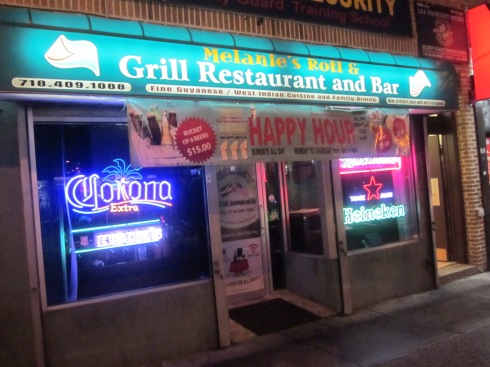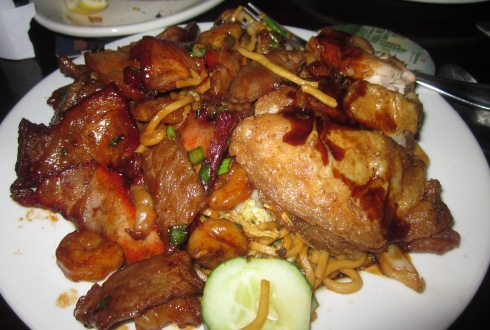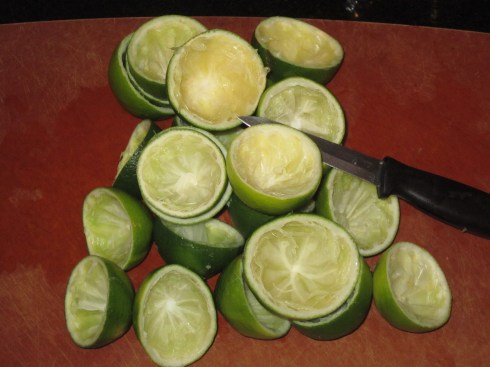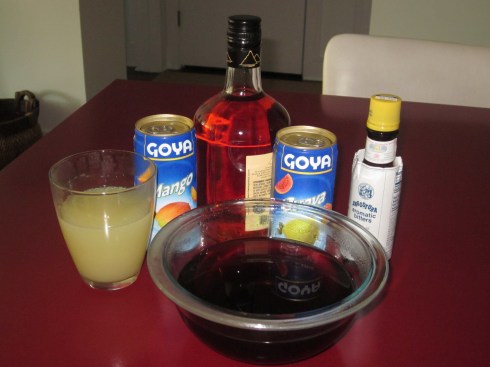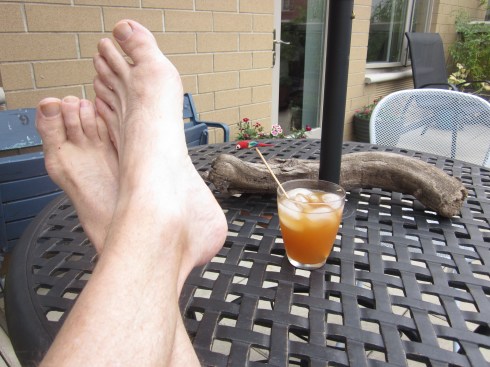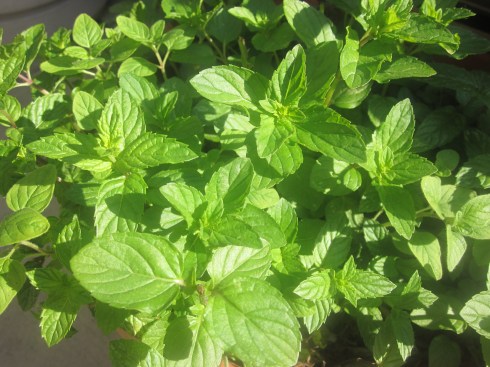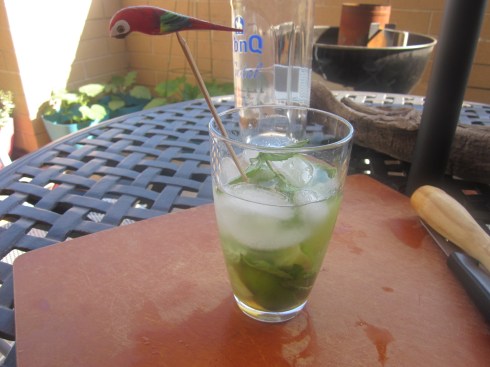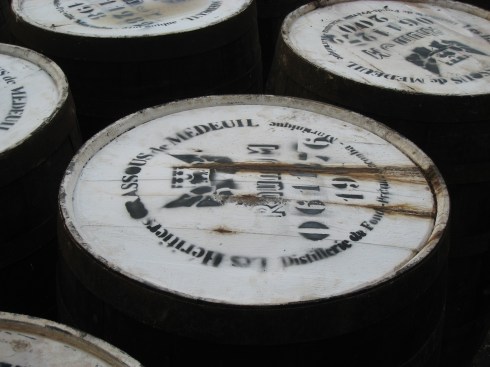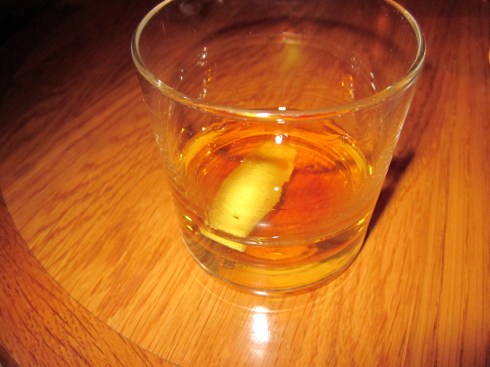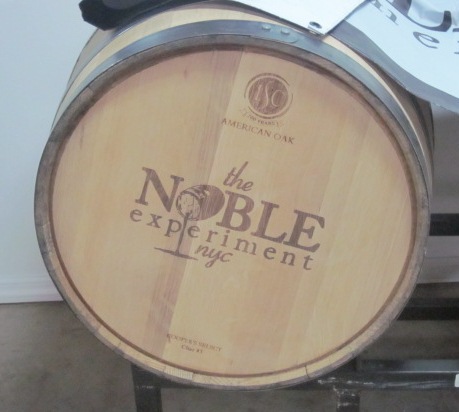
We had been informed by those who know about such things that a Polar Vortex had descended on the city. All I knew that it was very cold as I emerged from my car on barren 134th Street just off the Bruckner Boulevard. I was in what is known as the “Mott Haven” section of the Bronx. I know it as the south Bronx.
The wind was howling as I pushed open the non-descript heavy steel door and made my way up two flights to the world headquarters of the Tirado Distillery. I could hear music playing behind a closed door—disco from the 1970’s. I knocked. The music stopped. Dr. Renee Hernandez, the owner of, according to Dr. Hernandez, the Bronx’s first distillery since prohibition, was expecting me.
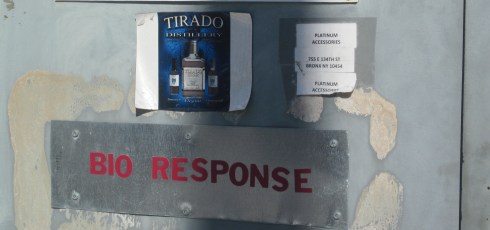
The Tirado Distillery door sign
The heat was on in the brightly lit room where folding tables and chairs held samples of the products made at the Tirado Distillery, but I was still cold. I was more familiar with rum among palm trees and sugar cane fields; often being whisked beach side to warm weather distilleries. Now, however, I was exploring that same spirit on grimy city streets within the grips of a polar vortex. I tried to keep an open mind as Dr. Hernandez offered me tasting sips of his products. I started with the corn whiskey.
“It’s organic,” Dr. Hernandez told me. “We get the corn from farms upstate.”
I winced at the taste, not that it was bad , but that I wasn’t quite ready for the bracing jolt it gave me.
“Bronx moonshine,” Dr. Hernandez called it. “It goes great in a ‘sex on the beach,’” he said.
I looked at him. He had to go and mention the beach?
I next tried the black rum. It was hearty; heavy-bodied in the style of what is known as Navy rums.
“I like to mix it with passion fruit juice,” Dr. Hernandez told me and I couldn’t argue. It needed something to cut its denseness.
“Where do you get your molasses for the rum,” I inquired. “Puerto Rico? The Dominican Republic? Jamaica?”
“New Jersey,” he answered.
I nodded, but said nothing.
“From International Molasses,” he added.
I understood but didn’t inquire further as to where New Jersey’s International Molasses got their molasses.
Finally I sampled the distillery’s “Maple Delight,” a blend of whiskey with a hint of local New York maple sugar. Surprisingly smooth, the Maple Delight was my favorite in the Tirado Distillery repertoire.
The sips had taken the chill off and Dr. Hernandez took me into the production facility down the hall which featured rows of plastic buckets used for fermentation, a few small stainless steel stills and boxes of empty bottles ready to be filled and labeled. From the loft-like facility, you could see the flickering lights of Manhattan.
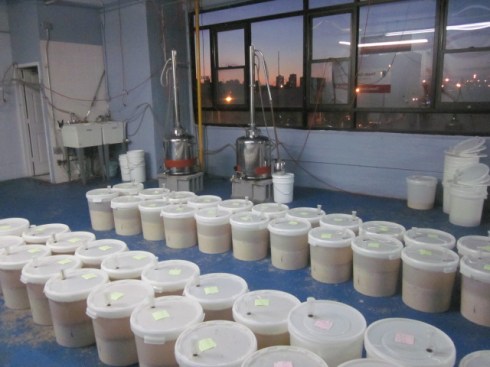
Tirado’s fermentation tanks.
“We only produce around 300 bottles a year and concentrate on making our products clean and smooth. You won’t get a hangover from our rum or whiskey.” Dr. Hernandez proudly proclaimed.
I thanked him for the personalized tour and made my way back out into the cold. I got into my car and turned up the heat. The last time I made the rum rounds was on the island of Martinique. There are eleven rum distilleries on that French Caribbean island and the local tourist board promotes visiting them with what they call “la route des rhums.” Here in frigid New York, after Tirado Distillery, I had two more to visit. Would my escapade qualify as a route des rhums?
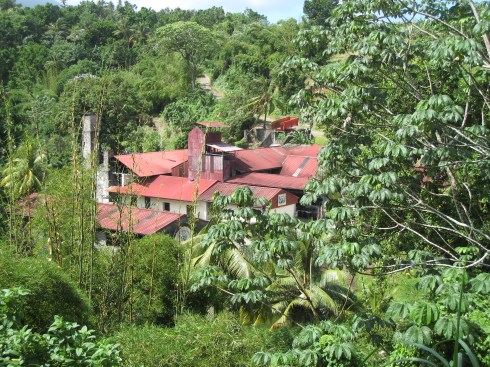
One of the distillery’s on Martinique’s “route des rhums.”
My next stop was Brooklyn and I soon found myself in an industrial, truck-crammed area similar to Mott Haven. I was in Williamsburg—or was it Bushwick—searching for my destination TNE (The Nobel Experiment)NYC, the distillery that makes another New York-produced rum called Owney’s. And I soon found it—the TNE NYC painted in big bold black letters above a graffiti-strewn steel door.
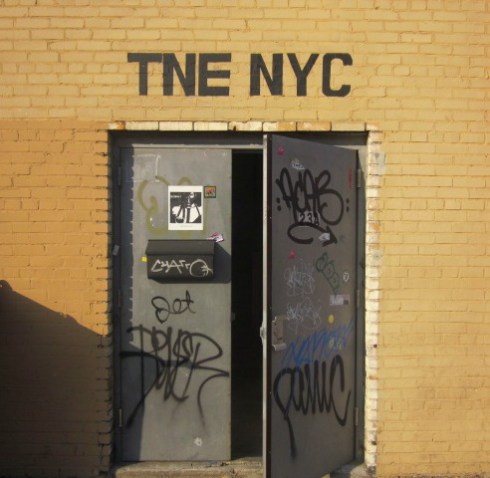
The door to TNE’s headquarters.
On one of my tropical, beach-centric rum assignments many years ago I met Owen Tulloch, the master blender for J. Wray & Nephew’s Appleton Estate rums in Jamaica. At the time, the esteemed Mr. Tulloch was grooming his young associate, Joy Spence, in both the scientific and the sensory ways of blending fine rums. Soon after we met, Mr. Tulloch retired and Ms Spence became the spirit industry’s first female master blender.
Now, almost twenty years later, many miles north of the Caribbean during—I have to say it again— a polar vortex, I was greeted by Bridget Firtle, the CEO and founder of TNE who is not only another female master blender of fine rum, but one who also operates every physical aspect of the rum making process as well as distribution. The Noble Experiment is literally a one-woman show.
What can you say about a young, up and coming Wall Street and hedge fund mover and shaker who gives up that potentially very lucrative, yet soulless career for one that , albeit risky, actually enriches others’ (speaking of my own) lives by following her passion and creating a beloved (by me) hand-crafted spirit in her polar vortex-challenged hometown? That is what Bridget Firtle has done and some might think that maybe inhaling too many alcoholic vapors might have compromised her career choice decision while others, me included, applaud her for chasing her dream.
The Noble Experiment, so named as a nod to one of the terms associated with Prohibition when rum running was the rage, was housed in an open, airy room where towering mashing tanks and copper pot stills glittered in the natural light that poured through the big windows. The machinery looked imposing to me, but Ms. Firtle learned to handle them all expertly enough to churn out 23,000 bottles in her initial 2012 batch, and to also earn Owney’s Rum, named in another nod to the Prohibition Era after notorious bootlegger, Cotton Club owner, and gangster, Owney Madden, a silver medal at the 2013 New York International Spirit’s Competition.

Some of the machinery at the TNE Distillery run by Bridget Firtle.
Fortified with sugar cane molasses from Florida and Louisiana and made with that same coveted New York water that is credited with making New York bagels and pizza so good, Owney’s is a smooth white rum. The sip offered me at the handsome wood burnished bar in the lobby of the distillery reflected that distinctive water; clean enough to enjoy on the rocks with a wedge of lime or, even better, as the soul of a classic daiquiri. Firtle’s own experiment is not only noble, but very impressive and though Wall Street might be the “poorer” for losing her talents, the New York rum establishment, such as it is, is much richer for it.

I wasn’t far from the next stop in my urban rum route, also in Brooklyn, and even though I found my way to Red Hook, I wasn’t really sure exactly where I was going and what I was going to see. My interest was in Cacao Prieto rum, but did that mean I needed to go to the Widow Jane bourbon factory that was associated with Cacao Prieto, which was also, as its name connotes, a chocolate making enterprise. I noticed the colorful mural of workers harvesting sugar cane on the wall of a warehouse. I knew I had to be close and then around the corner saw the old brick building with the prominent “Cacao Prieto” sign on it. I was where I wanted to be. At least I thought I was.

Harvesting sugar cane in Red Hook during a Polar Vortex.
The doors were locked but a sign on it left a phone number to call to gain entry or to “knock loudly.” I knocked loudly. A man in worker coveralls opened up. I told him what my interest was. Another man, bearded and heavily tattooed with a roguish, Captain Jack Sparrow smile, introduced himself as Vince Oleson. “I’m a distiller,” he said.
A distiller at a rum distillery could certainly help me. And Mr. Oleson did. He took me past the American and French oak barrels, copper pot stills, through a small yard where live chickens roamed, and then to the fermentation tanks in a back room. Oleson told me how the rum was made from organic sugar cane from Daniel Preston’s, the owner and founder of Cacao Prieto, family’s farm in the Dominican Republic where the cacao for the artisanal chocolate made at Cacao Prieto also came from. He explained how the water used was from the “Widow Jane” mine in the Catskills and packed with minerals adding even more depth to the finished product, and how the cacao beans were actually fermented with the white rum to create their signature and unique “Don Rafael Cacao Rum,” and “Don Esteban Cacao liqueur.”
I did a lot of nodding as Oleson schooled me in the Red Hook rum making process. It all sounded almost too impressive. No one ever emphasized the water during my various other Caribbean rum tours. No one blended organic cacao with organic sugar cane in Martinique, Jamaica, Barbados or any of the other rum-making islands I’d visited. But this was Brooklyn, home of the artisanal food movement: I should have known.

After the tour, Oleson set me up at their tasting bar with samplings of a number Cacao Prieto’s rums including a small batch produced of what they call Widow Jane Rye rum, or rum aged in the oak barrels formerly used to age the company’s rye. The result was a subtle smoky flavor from the rye. “With this you could make a rum sazerac,” I said.
“Now that’s a great idea,” Oleson replied, again with the rougish, Jack Sparrow smile.
After that sip I was full of great ideas and it got even better when I sampled Cacao Prieto’s Don Rafael Cacao rum; the company’s smooth white rum infused with their own rich chocolate. But this wasn’t just chocolate, this was “cacao,” and the flavor was both intense and clean. Finally I sipped the white rum. Like Owney’s, it’s was fresh, fortified by that mineral-rich New York water and would work just fine on the rocks or in a lightly flavored drink like a daiquiri or even a French Caribbean Ti Punch.
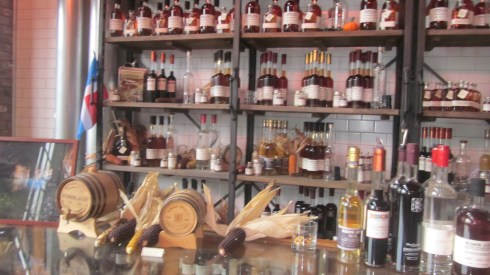
The Cacao Prieto Tasting Bar.
I let Mr. Oleson get back to work. There were rums to distill. My self guided route des rhums was over and I was stuck in traffic on the BQE. The windshield of my car was beginning to ice and I turned on the defroster. Now that my hometown had its own burgeoning rum making industry did I really need to travel all the way to those lush, warm tropical islands to experience what had been lacking here? As I pondered that question, there was more blather on the radio about the polar vortex. By the time I crossed the Kosciusko Bridge into Queens, I pondered it no more.

The scenic Polar Vortex rum route.
Tirado Distillery
755 W. 134th St.
The Bronx
tiradorum.com
The Noble Experiment
23 Meadow Street,
Brooklyn
tneynyc.com
Cacao Prieto
218 Conover Street
Red Hook, Brooklyn
cacaoprieto.com
Tags: Bronx, culture, Drinks, humor, New York City, Polar vortex, Rum, Travel

